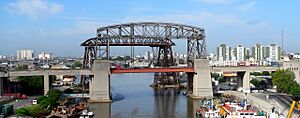Matanza River facts for kids
Quick facts for kids Matanza |
|---|
The Matanza River is a very important waterway in Argentina. It's known by several names, like Río de la Matanza (which means "the slaughter river" in English), Río Matanza, Río Mataderos ("slaughterhouses river"), Río de la Manzana ("the apple river"), or simply Riachuelo ("little river").
This river is about 64-kilometre (40 mi) long. It starts in the Buenos Aires Province and forms the southern border of the main city of Buenos Aires. The river flows into the Río de la Plata near places like Tandanor and Dock Sud. The famous La Boca neighborhood and the Boca Juniors soccer club are also found near where the river meets the bigger water. The Spanish word boca means "mouth."
Parts of the river's path have been changed and straightened by engineers, especially closer to its mouth.
About the River
From where it begins all the way to La Noria Bridge on Avenida General Paz, people usually call it Río La Matanza. After that point, it's often called Riachuelo. About 3.5 million people live in the area that drains into this river, which covers about 2,240 km2 (865 sq mi).
Sometimes, a strong south-easterly storm wind, called a Sudestada, can stop the Riachuelo's water from flowing into the Río de la Plata. This often causes floods in low-lying areas like La Boca and Barracas. To help prevent these floods, several projects have been done since 1995.
The Matanza River has a few main streams that flow into it. These are the Cañuelas, Chacón, and Morales streams in Buenos Aires Province. The Cildáñez stream, which is now underground in pipes, also joins the river in the Greater Buenos Aires area.
Environmental Challenges
The Matanza River basin is one of the most polluted rivers in Latin America. It's even considered one of the most polluted places in the world, with very high levels of lead. A big reason for this pollution is that many factories along the river, especially those that process animal hides (tanneries), release a lot of industrial waste into it.
Some of the most dangerous pollutants are heavy metals and dirty water from the ground layers around the river. Studies have shown that about 25% of children living in poor neighborhoods along the river have lead in their blood. Many more children also suffer from stomach problems and breathing issues.
The pollution of the Riachuelo has been a big concern for a long time, even since the 1860s. Famous people, like artist and Greenpeace activist Nicolás García Uriburu, have tried to bring attention to the problem. In 2010, on World Water Day (March 22), he even dyed the river green to highlight the pollution.
Past Cleanup Efforts
In 1993, a plan was made to clean up the Riachuelo. It was supposed to take three years and had a large budget. However, this project never really got started or finished. Critics pointed out that the cleanup only removed old sunken ships, but nothing was done to stop new ones from sinking or to prevent more pollution.
In 2006, there was new hope when President Néstor Kirchner said that improving the Riachuelo would be a top priority. While some efforts were made, the river still causes health problems and makes the nearby neighborhoods look run down. Along with environmental cleanup, there have also been ideas to improve the neighborhoods around the river.
Supreme Court Case
In 2004, a group of people living in a very polluted area along the Matanza River decided to take action. They filed a lawsuit against the national government, the provincial government, the local city government, and several private companies. This case was called the Mendoza case, named after Beatriz Mendoza, one of the residents who started it.
They asked for money to make up for the environmental damage they faced because of the river's pollution. They also demanded that the polluting activities stop. In July 2008, the highest court in Argentina, the Supreme Court of Argentina, made its decision. The Court agreed that the national government, along with the city and province of Buenos Aires, were responsible for the environmental damage to the river.
The Court said that the residents had a right to a healthy environment and that the governments had to fix the damage. The Court ordered the governments to do three main things:
- Improve the quality of life for the people living in the area.
- Clean up the environmental damage in the river basin.
- Stop any more pollution from happening.
However, the Court did not make a decision about the private companies involved. Five environmental groups (called NGOs), including Greenpeace, who had been working on the case, were also asked by the Court to help. They were appointed to watch over the river and nearby areas to make sure that the planned improvements and cleanup work were actually being done.
See also
 In Spanish: Río Matanza-Riachuelo para niños
In Spanish: Río Matanza-Riachuelo para niños



